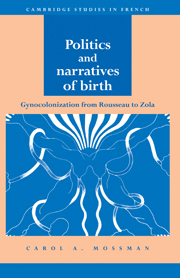Book contents
- Frontmatter
- Contents
- Acknowledgements
- A note on translations
- Introduction: conception of this book
- Cycle 1 Stendhal: delivering a plot
- Cycle 2 Production, reproductions, and narrative form: Adolphe
- Cycle 3 Gynocolonization: Rousseau, Michelet, Zola and the nineteenth-century French novel
- Conclusion
- Notes
- Bibliography
- Index
- CAMBRIDGE STUDIES IN FRENCH
Cycle 1 - Stendhal: delivering a plot
Published online by Cambridge University Press: 22 September 2009
- Frontmatter
- Contents
- Acknowledgements
- A note on translations
- Introduction: conception of this book
- Cycle 1 Stendhal: delivering a plot
- Cycle 2 Production, reproductions, and narrative form: Adolphe
- Cycle 3 Gynocolonization: Rousseau, Michelet, Zola and the nineteenth-century French novel
- Conclusion
- Notes
- Bibliography
- Index
- CAMBRIDGE STUDIES IN FRENCH
Summary
death and transfiguration in the vie de henry brulard
That Henri Beyle, alias Stendhal, was born in Grenoble on January 23, 1783, we know from his autobiography, the Vie de Henry Brulard. Pseudonymous title notwithstanding, this is a narrative which falls into the autobiographical tradition of Rousseau, as Béatrice Didier has demonstrated (“Roman,” 220–23). Indeed, the chameleonesque Stendhal himself declared when writing to Levavasseur, the publisher of Le Rouge et le noir: “I am now writing a book which may be a great folly; it is My Confessions, like Jean-Jacques Rousseau's except for the style, with greater frankness” (Correspondance, III, p. 140).
Despite this literary lineage, however, there are several aspects of Beyle's “Confessions” which make them rather singular. For example, contrary, again, to what its title suggests, the book closes on an adolescent Henry Brulard. Thus the entire emphasis is shifted onto childhood, giving the work a distinctly modern cast. And a woeful tale it is: Henry recounts in detail a sort of reign of terror administered by his father and his Aunt Séraphie which he was forced to endure following his mother's death when he was seven.
More than a document of interest to those devotees known as Stendhalians, the Vie de Henry Brulard presents a precious record of France's greatest social upheaval as seen through the eyes of a mutinous child. It is a well-known fact that for Henri Beyle, personal history was inextricably tied to national history.
- Type
- Chapter
- Information
- Politics and Narratives of BirthGynocolonization from Rousseau to Zola, pp. 19 - 71Publisher: Cambridge University PressPrint publication year: 1993



